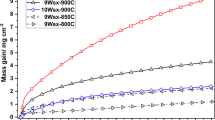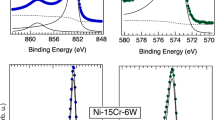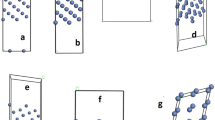Abstract
PREREQUISITES for reversible temper embrittlement of steel1 are the presence of a trace impurity2 (Sb, Sn, As or P) and a major alloying element3,4 (Ni, Cr or Mn). Auger electron spectroscopy (AES) demonstrated that in the embrittled state these elements are segregated to within the first few monolayers of the high angle boundaries5,6. The segregation is reversible and can be removed by heating at temperatures above the embrittlement range, whilst still within the α field (that is > 600 °C). It has been postulated7 that the segregation behaviour can be explained using equilibrium thermodynamics. It is proposed that the trace impurities interact more strongly with the major alloying elements than the Fe matrix and hence the chemical potential of the system is reduced by segregation to the high angle boundaries with the formation of bi-dimensional complexes (such as Ni3Sn2) Mn3P and Cr3P). No experimental evidence is available for the existence of such complexes. AES gives no information regarding the chemical bonding of the segregants but it has been shown8, using X-ray photoelectron spectroscopy (XPS), that the segregated Mn on embrittled fracture surfaces of a 2% Mn steel is in a different chemical state to that on unembrittled surfaces. We report here preliminary results from a specially prepared 3% Ni steel, doped with 119Sn, which were obtained using Mössbauer spectroscopy to monitor changes in the nearest-neighbour atoms of the Sn atoms as a function of heat treatment in the temper embrittlement temperature range.
This is a preview of subscription content, access via your institution
Access options
Subscribe to this journal
Receive 51 print issues and online access
$199.00 per year
only $3.90 per issue
Buy this article
- Purchase on Springer Link
- Instant access to full article PDF
Prices may be subject to local taxes which are calculated during checkout
Similar content being viewed by others
References
McMahon, C. J., Jr Am. Soc. Test. Mater. STP 407, 127–167 (1968).
Steven, W. & Balajiva, K. J. Iron Steel Inst. 193, 141–147 (1959).
Low, J. R., Jr, Stein, D. F., Turkalo, A. M. & Laforce, R. P. Trans. Am. Inst. Min. metall. Petrol. Engrs 242, 14–24 (1968).
Krahe, P. R. & Guttmann, M. Scripta Metall. 7, 387–394 (1973).
Marcus, H. L. & Palmberg, P. W. Trans. Am. Inst. Min. metall. Petrol. Engrs 245, 1664–66 (1969).
Stein, D. F., Joshi, A. & Laforce, R. F. Trans. Am. Soc. Metals 62, 776–783 (1969).
Guttmann, M. Surface Science 53, 213–227 (1975).
Coad, J. P., Riviére, J. C., Guttmann, M. & Krahe, P. R. Acta Metall. 25, 161–171 (1977).
Edwards, B. C., Bishop, H. E., Riviére, J. C. & Eyre, B. L. Acta Metall. 24, 957–967 (1976).
Author information
Authors and Affiliations
Rights and permissions
About this article
Cite this article
EDWARDS, B., EYRE, B. & CRANSHAW, T. Ni-Sn interaction in temper embrittled steel detected by Mössbauer spectroscopy. Nature 269, 47–48 (1977). https://doi.org/10.1038/269047a0
Received:
Accepted:
Issue Date:
DOI: https://doi.org/10.1038/269047a0
This article is cited by
-
Validity of Valence Estimation of Dopants in Glasses using XANES Analysis
Scientific Reports (2018)
-
Detection of Ni–Sn phases in temper embrittled Ni–Cr steels
Nature (1979)
Comments
By submitting a comment you agree to abide by our Terms and Community Guidelines. If you find something abusive or that does not comply with our terms or guidelines please flag it as inappropriate.



